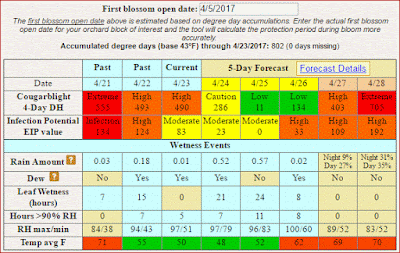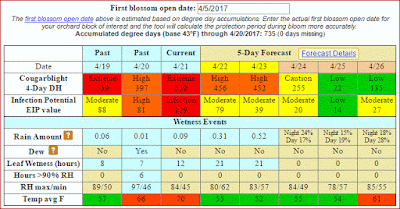NOTE: This year for fire
blight risk assessment, we are comparing graphics from Maryblyt 7 and from the
Cougarblight model as shown on our NEWA site. We are using the same
weather data from our NEWA station to make these
comparisons in both predictive programs.
CAUTION: The observations, conditions, and recommendations reported
for Winchester, VA are provided as a guide to fire blight risk assessment only
for the immediate area of the Virginia Tech AREC located six miles southwest of
Winchester. Use of the information reported here for making orchard management
decisions outside of that area is not our intent. Fruit producers outside of
that area are encouraged to consult their state extension specialists for
information similar to that provided here.
SCAB and RUSTS: We
have just seen extended wetting of more than 46 hours. Because apple scab
lesions resulting from infection periods during the period March 26 to Apr 7
may have been present, consider this to be a heavy secondary infection period. Also, because of the high susceptibility of developing fruits to quince rust, it is
suggested that fungicides with strong after-infection activity against rusts
and scab be included in the next fungicide application.
 |
| Maryblyt graphic for Winchester, Apr 26, 2017. Click to enlarge. |
FIRE BLIGHT:
Above is a cropped graphic from the Maryblyt 7 program, using Apr 5 as the date
for first bloom open on Idared cultivar. Early-blooming cultivars still have scattered
susceptible bloom, and later cultivars are at petal fall but with much
susceptible bloom in the Winchester and central Virginia areas. Some recently planted
trees still have much susceptible bloom. The temperature and rainfall data are
current through Tuesday evening, Apr 25. Predicted weather conditions are shown
for April 26-May 1. The components of fire blight risk are indicated in the
columns labeled B (blossoms open), H (degree hours for epiphytic bacterial
populations), W (wetting by rain or dew), and T (average daily temperature 60 F
or above). For infection to be predicted, wetting must occur after the EIP
(epiphytic infection potential) reaches 100 or higher. Based on recorded
temperatures and wetting, the risk column shows high risk and possible infection with
any wetting Apr 11-12, 15-18, and 21, and if bloom persists, Apr 27-May 1.
Infection was indicated for Apr 12, 15-17 and 21. Predicted warming
temperatures will again increase risk wherever susceptible bloom remains Apr 26-May
1. Note that risk can change quickly with warmer than predicted temperatures
and wetting. In situations where all other requirements for infection have been
met except wetting (as for Apr 27-May 1), wetting from any spray application
(fungicide, insecticide, or thinning spray) can provide the wetting trigger for
infection to occur. In high-risk situations, a protective streptomycin
application is recommended ahead of predicted infection. Continue to protect
late bloom and open bloom on recently planted trees as needed.
The BBS column is tracking predicted
symptom development for the first infection Apr 12 and symptoms are predicted
to appear Apr 27. Later infections are tracked with letters b-d, and symptoms
for those are predicted to appear Apr 28-30. The CBS column indicates
progression toward the appearance of canker margin symptoms due to extension of
overwintering cankers from last year, which would be predicted to occur after
that value reached 100 Apr 22. Canker advancement cannot be prevented by
chemical treatment at this time and the presence of symptoms will signal build-up
of inoculum which could become a factor in the event of a trauma blight/shoot
blight situation due to hail injury, etc. To
offset the potential for shoot tip infection in an active fire blight year such
as this one, apply the plant growth regulator, prohexadione-calcium (Apogee,
Kudos), at late bloom. Shoot blight suppression results from hardening off of
vegetative shoot growth starting about 10 days after the initial application.
The fire blight outlook will be updated Friday, Apr 28.
Below is the graphic
from the Cougarblight model as shown on our NEWA site. Note that we selected orchard
blight history option as “Fire blight occurred in your neighborhood last year”
and first blossom open date as 4/5/2017. (This date must be re-set each time
this site is accessed). Cougarblight shows color-coded risk as “high” for Apr
27 and “extreme” for Apr 28-30.
 |
| Cougarblight graphic for Winchester, Apr 26, 2017. Click to enlarge. |












